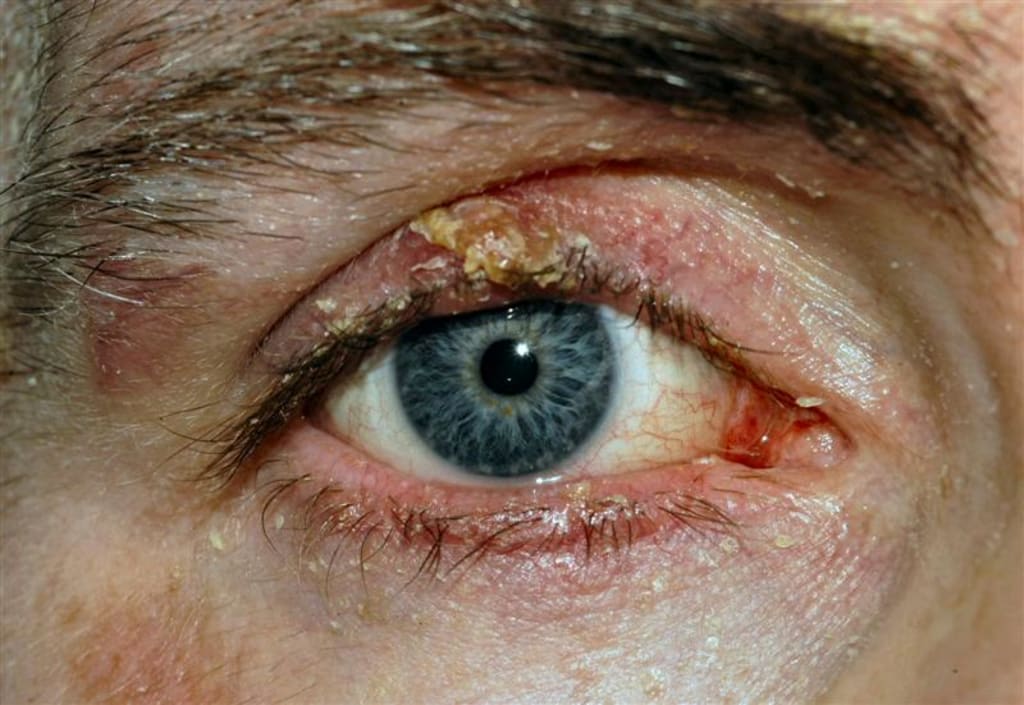
Intro...
The human eye is an incredible organ, allowing us to experience the world around us with vivid clarity. However, like any other part of our body, it is susceptible to various conditions that can affect its health and function. One such common condition is blepharitis, which refers to the inflammation of the eyelids. Blepharitis can be uncomfortable and persistent, but with proper understanding, prevention measures, and treatment, its impact can be minimized. In this comprehensive blog post, we will delve into the causes, symptoms, prevention measures, and available treatment options for blepharitis.
Causes of Blepharitis:
Blepharitis can arise from several factors, and often it is a result of a combination of causes. Understanding these causes can help us grasp the complexity of the condition:
1. Bacterial Infection: Bacteria, particularly Staphylococcus aureus, can colonize the eyelids, leading to blepharitis. The bacteria cause an overgrowth of microorganisms on the lid margin, resulting in inflammation.
2. Meibomian Gland Dysfunction: The meibomian glands, located along the eyelid margins, produce an oily substance called meibum. If these glands become blocked or dysfunctional, it can lead to a disturbance in the tear film's composition, resulting in blepharitis.
3. Demodex Mites: Tiny mites known as Demodex folliculorum can inhabit the eyelashes. In some individuals, an overpopulation of these mites can trigger an inflammatory response, leading to blepharitis.
4. Seborrheic Dermatitis: People with seborrheic dermatitis, a chronic skin condition characterized by redness, scaling, and oily patches, are more prone to developing blepharitis.
Symptoms of Blepharitis:
Blepharitis presents with various symptoms that can range from mild to severe. The following are common signs and symptoms associated with the condition:
1. Redness and Swelling: Inflamed eyelids often appear red and swollen, leading to a puffy and irritated appearance.
2. Itching and Irritation: Individuals with blepharitis frequently experience itching and a persistent sensation of having something in their eyes.
3. Crusty Eyelids: The accumulation of debris, such as oily flakes or bacterial crusts, along the eyelid margins can cause the eyelids to become crusty.
4. Watery or Dry Eyes: Blepharitis can disrupt the normal functioning of the tear film, leading to either excessive tearing or dryness in the eyes.
5. Sensitivity to Light: Some people with blepharitis may develop increased sensitivity to light, making their eyes more susceptible to discomfort in bright environments.
Prevention Measures for Blepharitis:
While some factors contributing to blepharitis may be beyond our control, there are preventive measures that can help reduce the risk of developing the condition or manage its symptoms effectively:
1. Maintain Good Eyelid Hygiene: Regularly clean your eyelids using a mild cleanser or baby shampoo. Gently scrub the base of the eyelashes with clean fingers or a cotton swab to remove debris and crusts.
2. Warm Compresses: Applying warm compresses to the eyelids can help soften the oil in the meibomian glands, facilitating its release and preventing blockage.
3. Avoid Eye Makeup Contamination: Ensure that your eye makeup, such as mascara or eyeliner, is not expired or contaminated. Replace eye makeup products regularly to reduce the risk of bacterial growth.
4. Practice Contact Lens Hygiene: If you wear contact lenses, follow proper hygiene practices. Clean and disinfect your lenses as instructed and avoid wearing them when your eyes are already irritated or inflamed.
5. Manage Skin Conditions: If you have underlying skin conditions like seborrheic dermatitis, consult a dermatologist for appropriate treatment and management strategies.
Treatment Options for Blepharitis:
When it comes to treating blepharitis, a multi-faceted approach is often necessary. Here are some common treatment options:
1. Eyelid Hygiene: Consistently following proper eyelid hygiene practices, as mentioned earlier, can significantly improve blepharitis symptoms and prevent flare-ups.
2. Antibiotics: In cases where bacterial infection is present, topical or oral antibiotics may be prescribed to combat the infection and reduce inflammation.
3. Anti-Inflammatory Medications: Steroid eye drops or ointments may be recommended to alleviate inflammation and provide relief.
4. Tear Substitutes: Artificial tears or lubricating eye drops can help relieve dryness and improve the stability of the tear film.
5. Warm Compresses and Lid Massages: Regularly applying warm compresses to the eyelids and gently massaging them can help unclog the meibomian glands and promote healthy tear film production.
In addition to medical treatment and preventive measures, there are some home remedies and self-care practices that can complement the management of blepharitis. Here are a few home solutions you can try:
1. Warm Compresses: Applying warm compresses to the eyelids can be done at home and is an effective way to reduce inflammation and loosen any blockages in the meibomian glands. Soak a clean washcloth in warm water and gently place it over closed eyelids for about 5-10 minutes. Repeat this several times a day to help unclog the glands and improve symptoms.
2. Lid Scrubs: You can create a homemade lid scrub solution by diluting a few drops of baby shampoo or mild cleanser in warm water. Dip a clean cotton swab or a lint-free cloth into the solution and gently scrub the base of your eyelashes, keeping your eyes closed. This helps remove debris and crusts from the eyelid margins. Rinse your eyelids with warm water afterward and pat them dry with a clean towel.
3. Tea Tree Oil: Tea tree oil possesses natural antibacterial and anti-inflammatory properties, which can be beneficial for blepharitis. Dilute a drop or two of tea tree oil in a tablespoon of coconut oil or olive oil. With a clean cotton swab or fingertip, apply the diluted solution to the base of your eyelashes, avoiding direct contact with the eyes. Leave it on for a few minutes, then rinse thoroughly with warm water. It's important to note that tea tree oil may cause irritation in some individuals, so discontinue use if any discomfort occurs.
4. Omega-3 Fatty Acids: Incorporating foods rich in omega-3 fatty acids into your diet or taking omega-3 supplements may help reduce inflammation and promote overall eye health. Sources of omega-3 fatty acids include fatty fish (salmon, tuna, sardines), flaxseeds, chia seeds, and walnuts.
5. Avoid Eye Irritants: Minimize exposure to potential irritants that can exacerbate blepharitis symptoms. This includes avoiding smoke, dust, and allergens. If you wear contact lenses, make sure to follow proper hygiene practices and avoid wearing them when your eyes are already irritated.
While these home solutions can provide relief for mild cases of blepharitis, it's important to consult with an eye care professional for a comprehensive evaluation and appropriate treatment plan. They can assess the severity of your condition and provide personalized guidance to manage blepharitis effectively.
At Last...
Blepharitis, while a common and bothersome condition, can be effectively managed with proper understanding, prevention measures, and treatment. By practicing good eyelid hygiene, maintaining eye health, and promptly seeking medical advice, individuals can alleviate symptoms, reduce the risk of complications, and improve their overall quality of life. If you suspect you have blepharitis or experience persistent eye discomfort, consult an eye care professional for an accurate diagnosis and personalized treatment plan. Remember, proactive care is key to maintaining optimal eye health and ensuring clear vision for years to come.






Comments
There are no comments for this story
Be the first to respond and start the conversation.